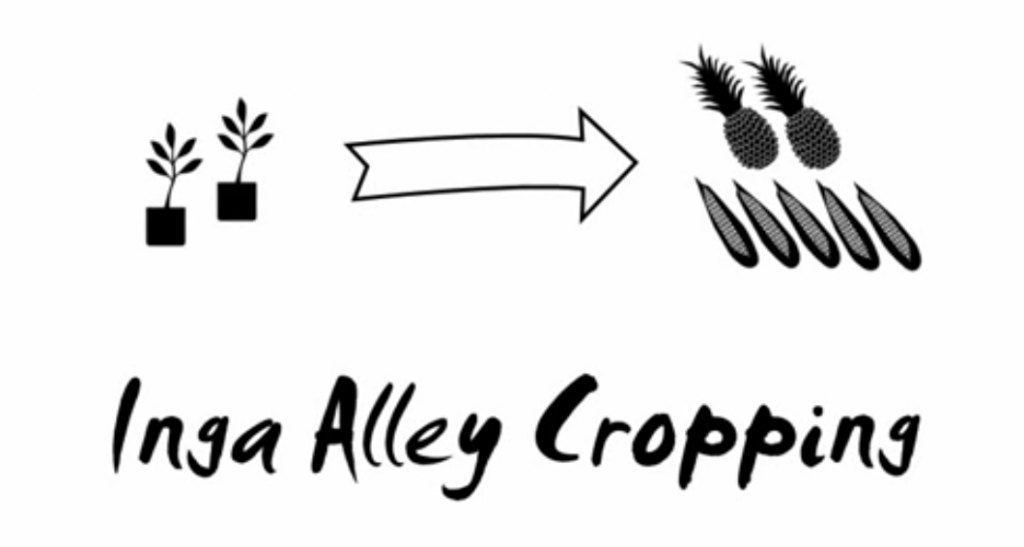I never heard of Inga alley cropping until a week ago. Now I’m somewhat obsessed with it.

Freeze frame from a video that opened a whole new world
One of the benefits of sharing my videos and posts publicly is the interaction I get to have with other people.
In this video I mention how I intercropped my corn and pigeon peas in imitation of the natives:
In response, a YouTuber commented:

Here’s the video he mentioned on inga alley cropping:
Now I’m not ignorant of alley cropping as a useful agricultural method, particularly on slopes. I’ve done some study on Sloping Agricultural Land Technology (SALT) since moving here and realizing what a pain in the neck it is to garden on an incline and how important it is to maintain the soil and keep it from rapidly washing away downhill and into the river.
What I was ignorant about was how useful Inga species are. The only one I knew about – and which I have sadly not been able to find here – is the “ice cream bean” tree beloved of Geoff Lawton. It’s a nitrogen-fixing with edible pulp in the pods and a rapid growth that makes it excellent for establishing a food forest canopy and as a nurse tree to less vigorous species.
Chasing Down More on Inga Alley Cropping
I responded to Alex on Youtube:
“Alex – thank you for the link. I’ve used “chop-n-drop” in my previous food forest systems but hadn’t considered the possibilities for weed reduction via deliberately growing trees like that. Love the idea and will see if I can find a place to test it. The corn and pigeon peas mix is the way the natives grow them. I am learning what they do here first, then doing my own experiments on the side.”
In response he wrote:
“Well, if you love this idea I might as well point you in the right direction for further research. Mike Hands pioneered this system over 20 years ago as a way to stop the destructive pressure of slash and burn ag on tropical rain forests. He has an NGO dedicated to spreading the technique. http://www.ingafoundation.org/
The best manual put out on the technique IMO is Integrated Farming Manual available for free here http://www.yaaxche.org/files/Agromanual2014.pdf. The manual was put out by the Ya’axché Conservation Trust and the Maya Mountain Research Farm. The Maya Mountain Research Farm in Southern Belize is a great place to visit to see the technique in action and to learn about all their successes and mistakes they have made in the last 25 years.
That might help you succeed and save you a few years of making various mistakes, well worth the trip. http://www.mmrfbz.org/“
That’s not too far away from me; however, it’s really hard to access… definitely would be an adventure. I would love to visit at some point. For now, I’m hunting down more on Inga alley cropping.
More Video
Here’s a fascinating video on how inga alley cropping is being put into action to save rainforests in Honduras:
I could see systems like this being put in place in sandy Florida plots in order to improve the soil rapidly and build biomass. You could cut the trees to make biochar as well. You could do this with moringa, leucana, heck, even mulberry! You won’t get the nitrogen fixation but you would get the shade and the valuable dropped mulch on the ground.
I have identified a species of Inga in the local jungle which I believe to be Inga oerstediana. It’s in bloom right now… when it sets pods, you can guess what I’ll be doing with the seeds.
So many ideas… I feel like I’m going to leave this mortal coil long before I explore all the many trails of research I wish to pursue.
Anyone else ready to go out and start planting tight rows of trees in your gardens? Anyone?


13 comments
Awesome idea! I grow one inga tree but its only about 4′ tall now. Cannot wait to try the pods!
One interesting thing I’ve heard about bio char I’d like to share. Since I’ve seen you mention it a few times. Not sure its true or not but maybe you can find a real answer. Anyways I saw people say small biochar usage for small personal areas is great and useful for gardening. However I heard too that if it were used on the grand scale of feeding the planet it would be horrible. Basic chemistry: if you sequestered too much carbon in the ground at first it’d be fine but nature would try and balance the carbon in the soil. Then it would create a giant oxygen sink on a scale so massive it would suck enough out of the atmosphere causing serious trouble for us. Idk maybe…any light you could shine on this???
I dunno.
I don’t believe in the specter of anthropogenic climate change and the various “biochar will save the world!” articles and books I’ve seen strike me as somewhat ridiculous.
My guess is that they’re thinking that too much taking away of carbon would disrupt the natural cycle of decay and reclamation. On a huge enough scale, I could see that as feasible.
Yet at this point… I’m really happy to play around with biochar for my gardens. I haven’t decided if it really helps or not but as you’ll see in tomorrow’s post I’m now leaning into the “yes” category.
I’d love to, but it appears that Leucaena leucocephala is illegal to grow in Florida. Do you think that moringa would make enough foliage if chopped? I’m just growing my first moringa now.
I think so, provided it doesn’t freeze. Leucana is listed as an invasive; however, if it ended up on your private property I’m not sure it would get you in trouble. And there are other good options worth trying, too.
[…] is find the contour of their slope, then let the native vegetation grow. It’s rather like Inga Alley Cropping, but with grass and weeds […]
I have been thinking about experimenting with Guamuchil (Pithecellobium dulce). It’s not as nice as Icecream bean but is drought tolerant and grows well in Southern California. Thorny.
I posted my thoughts this weekend – probably will work well.
Sounds great David
I had heard of Inga being used to establish coffee in a similar way. I should let you know that Inga edulus has a bit of a reputation for being super weedy here and most suggest not planting it (I live a few hours drive north of Geoff).
So does Leucaena leucocephala for Peter who mentioned it above, it lines highways/disturbed areas here. That doesn’t mean that either are necessarily a bad thing, but they can and will spread if climate suites. I read something interesting about Leucaena recently and its benefits as a food source when used with stock, pretty cool.
All the best
Dan
This is so cool! And to think that I threw away all my inga seeds this year! What a waste! This is definitely getting on my to-do list for 2020! Thanks David!
You bet. I just planted some myself.
Could this type of system be replicated in a more temperate climate using black locust, honey locust, paulownia, or mimosa in place of inga trees. Or perhaps a hedge of nitrogen fixing shrubs like sea buckthorn, autumn olive, or Siberian pea shrub in place of inga trees. I also imagine the crops in between rows could be divided into sections and used to establish a food forest over time. For example, you could plant potatoes in a section to reclaim the soil, then the following year plant garlic behind it, then follow that with a bean or pea that could act as a cover crop, and finally the next year plant a fruit/nut tree guild.
I think so. It would be awesome to try. Do it!
“I saw people say small biochar usage for small personal areas is great and useful for gardening. However I heard too that if it were used on the grand scale of feeding the planet it would be horrible. Basic chemistry: if you sequestered too much carbon in the ground at first it’d be fine but nature would try and balance the carbon in the soil. Then it would create a giant oxygen sink on a scale so massive it would suck enough out of the atmosphere causing serious trouble for us.”
No that’s not true. Biochar is mainly carbon…the raw material you find in most plants, trees, branches, leaves etc.
The more carbon you have in the soil the richer it gets and the more trees and plants will grow out of it sequestering even more carbon.
Much of the Amazon forests are the result of huge quantities of biochar in the soil creating highly stable “terra preta” soil full of carbon. The Amazon forests aren’t sucking oxygen out of the atmosphere (they’re pumping oxygen into the atmosphere) and they’ve been there for thousands of years…
https://en.wikipedia.org/wiki/Terra_preta
Most forests have a huge percentage of carbon in the soil and they’re also pumping oxygen in the soil not sucking it out so clearly whoever told you this is incorrect.
Comments are closed.